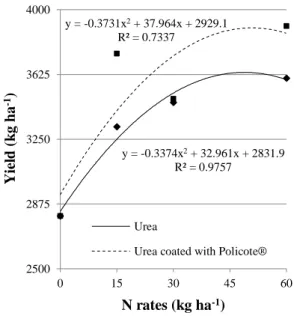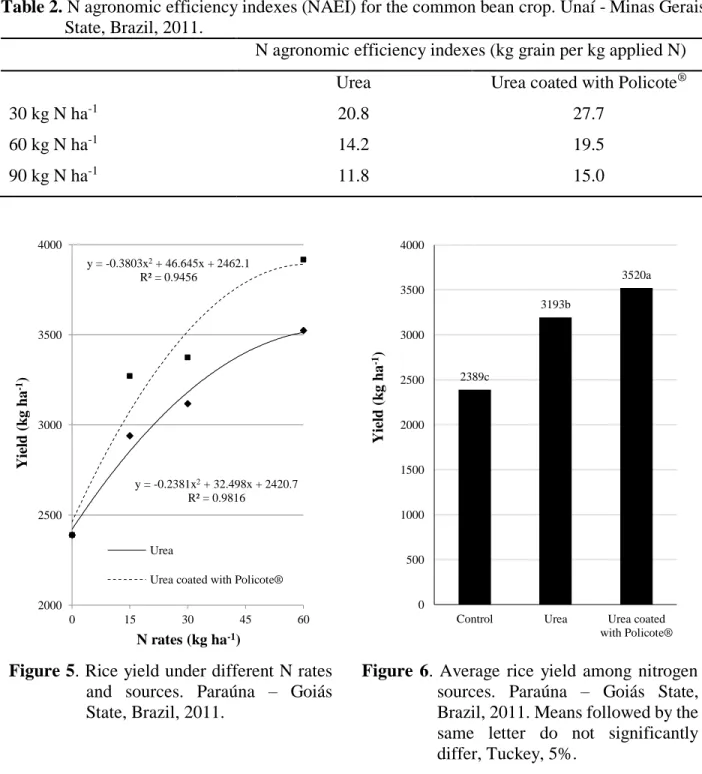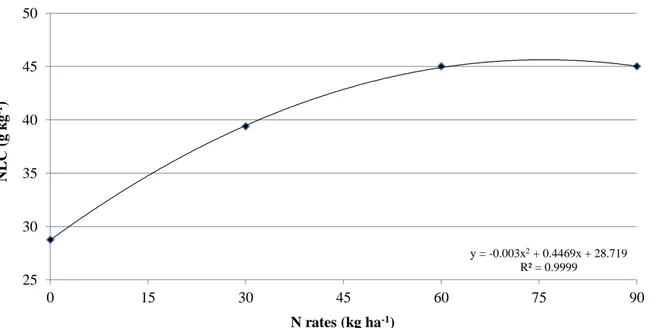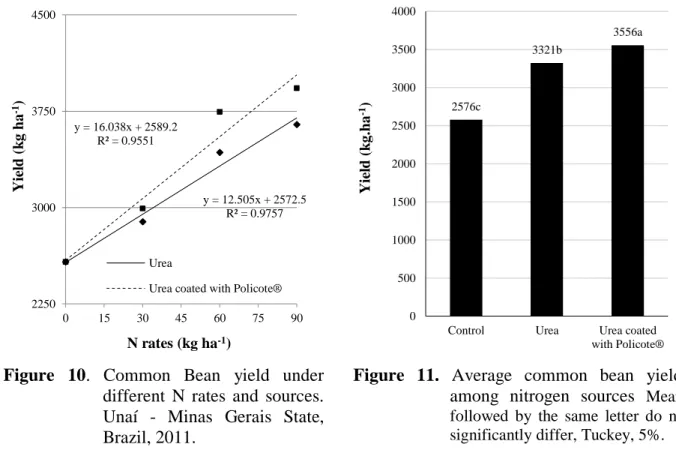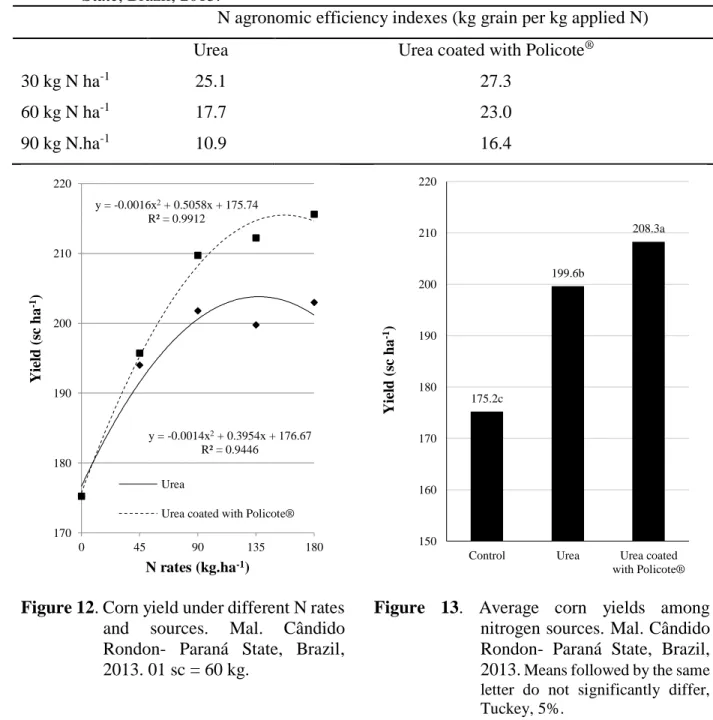196
NITROGEN FERTILIZATION OF RICE, COMMON BEAN AND CORN WITH ENHANCED-EFFICIENCY FERTILIZER
Roberto dos Anjos Reis Jr.1, Tarcício Cobucci2, Darci Sonego3
1Wirstchat Brazil. E-mail: roberto@wsct.com.br
2Integração Assessoria Agrícola. E-mail: cobucitarcisio@gmail.com
3Cooperativa Agroindustrial Copagril. E-mail: darci@copagril.com.br
ABSTRACT
Nitrogen has low-efficiency use in agriculture. Nitrogen fertilization with enhanced-efficiency fertilizers is one of the strategies used to increase its enhanced-efficiency. Polymer urea coating has been used to produce enhanced-efficiency fertilizers. There are a lot of polymers for this type of coating, which may lead to results divergence. Validation of this technology to guarantee its viability in agriculture is necessary. This study aimed to evaluate rice, common bean and corn morphological characteristics, foliar nitrogen contents, yields and nitrogen fertilization efficiency in response to nitrogen rates and sources. Field experiments, formed by a factorial design comparing nitrogen sources (urea and urea coated with Policote®) and rates, besides Control, were carried out. Increasing nitrogen rates elevated rice, common bean and corn morphological characteristics and yields. Urea coated with Policote® showed higher agronomic efficiency of nitrogen fertilization and higher yields than urea in rice, common beans and corn crops. The higher efficiency fertilizer (urea coated with Policote®) allowed to increase rice, common bean and corn yield, as well, to use lower rates to reach the same yield observed with conventional fertilizer. This can be used to increase food availability and to reduce fertilizer consumption.
Keywords: Agronomic efficiency, coated fertilizer, Policote®
ADUBAÇÃO NITROGENADA COM FERTILIZANTE DE EFICIÊNCIA AUMENTADA NAS CULTURAS DE ARROZ, FEIJÃO E MILHO
RESUMO
O nitrogênio tem baixo aproveitamento na agricultura. A adubação nitrogenada com fertilizantes de eficiência aumentada é uma das estratégias para aumentar sua eficiência. O revestimento de ureia com polímeros tem sido usado para produzir fertilizantes de eficiência
197 aumentada. Existem muitos polímeros para este tipo de revestimento, o que pode levar a divergência de resultados. A validação desta tecnologia para garantir sua viabilidade na agricultura é necessária. Objetivou-se avaliar as características morfológicas do arroz, do feijão e do milho, os teores foliares de nitrogênio, a produtividade e a eficiência da adubação nitrogenada em resposta às doses e fontes de nitrogênio. Experimentos de campo, formados por um delineamento fatorial, comparando fontes (ureia e ureia revestida com Policote®) e doses de nitrogênio, além do controle, foram realizados. O aumento das doses de nitrogênio elevou as características morfológicas do arroz, do feijão e do milho. A ureia revestida com Policote® apresentou maior eficiência agronômica da adubação nitrogenada e maior produtividade que a ureia nas lavouras de arroz, feijão e milho. O fertilizante de maior eficiência (ureia revestida com Policote) permitiu aumentar também a produção de arroz, feijão e milho e usar doses mais baixas para atingir o mesmo rendimento observado com o fertilizante convencional. Isso pode ser usado para aumentar a disponibilidade de alimentos e reduzir o consumo de fertilizantes.
Palavras-chave: Eficiência agronômica, fertilizante revestido, Policote®
INTRODUCTION
Nitrogen (N) is a mineral element required by plants, being part of proteins, nucleic acids and many other important plant constituents, including membranes and various plant hormones (SOUZA & FERNANDES, 2006). It is one of the most limiting nutrients in agricultural production, resulting in widely use of N fertilizers in agriculture. However, nitrogen fertilizer use efficiency in agriculture is low, resulting in economic losses and environmental problems. Mineral fertilizer is one of the most expensive inputs used in agriculture to achieve the desired productivity (BALIGAR et al., 2001), reinforcing the need to use it efficiently.
Several papers have carried out studies evaluating the use of N fertilization, finding efficiencies in the order 33% (RAUN et al., 1999), 44% (MATTOS JR et al., 2002), 41% (CHEN et al., 2008), 33% (ARNALL et al., 2009), 40-60% (MARTÍNEZ-ALCÁNTARA et al., 2013), and 25.2% (CANNAVO et al., 2013). Increasing nitrogen efficiency use is vital to elevate crop yield and quality, reducing nitrogen use, and improving soil, water and air quality (BALIGAR et al., 2001). Several strategies have been used to increase the N fertilization efficiency. Among them, the use of enhanced-efficiency fertilizers (EEF) has been studied more often, recently. Those
198
fertilizers contain aggregate technologies that control the release of nutrients or stabilize their chemical transformations in the soil, increasing their availability to the plant.
Such characteristics minimize the potential for nutrient losses to the environment when compared to conventional fertilizers. The EEF can be classified into three classes: slow release, controlled release and stabilized. Slow release fertilizers are fertilizers which release nutrients over a long period of time. A controlled release fertilizer is a granulated fertilizer that releases nutrients gradually into the soil within a given period, measured in months, in a controlled way. Stabilized N fertilizers work by delaying the conversion of N to forms that can be more readily lost to the environment through leaching, denitrification and volatilization. Polymer coated urea has been used to produce EEF. However, there are a lot of polymers for this type of coating. Studies comparing polymer-coated urea to common urea did not lead to conclusive results. While some reports point out advantages of using polymer-coated urea (FAN et al., 2004; NOELLSCH et al., 2009; WILSON et al., 2009; GARCIA et al., 2018), others point to its inefficiency when compared to common urea (NELSON et al., 2009; CAHILL et al., 2010; MCKENZIE et al., 2010; CIVARDI et al., 2011; PRANDO et al., 2013). Therefore, it may be erroneous to consider that all polymer coating will yield the same result. Validation studies of EEFs with polymer coating are thus necessary to ensure the viability of these fertilizers and guarantee its viability in agriculture. This study aimed to evaluate rice, bean and corn yields and nitrogen fertilization efficiency in response to nitrogen rates and sources.
MATERIAL AND METHODS
Four field experiments were conducted in rice, common beans and corn crop, using a randomized block design, with four replications, at different regions of Brazil.
In the rice crop, field experiments were conducted at Embrapa Arroz e Feijão, in Santo Antônio de Goiás, Goiás State, Brazil (16o 28’ 00” S, 49o17’00” W and 823 m of altitude), and in Paraúna, Goiás State, Brazil (16o 56’ 52” S, 50o26’55” W and 721 m of altitude). The climate of the region in Santo Antônio de Goiás and Paraúna is Aw, according to the Köppen classification, with an annual average temperature of 23.1 and 23.8 oC, respectively, and annual rainfall of 1,472.8 and 1495 mm, respectively. The soils used in Santo Antônio de Goiás (Red Latosol) and Paraúna (Red Latosol) presented the following chemical characteristics (0–20 cm): pH (H2O) = 5.7 and 4.2;
O.M. = 24 and 18 g dm-3; P (Mehlich-1) = 20 and 6.4 mg dm-3; K (Mehlich-1) = 2.5 and 2.5 mmol c
199 dm-3; Ca = 30 and 15 mmolc dm-3; Mg = 11 and 5 mmolc dm-3; Al = 0 and 3 mmolc dm-3; H+Al =
45 and 51 mmolc dm-3; clay = 410 and 390 g kg-1; silt = 200 and 240 g kg-1; sand = 390 and 270 g
kg-1, respectively. The experiments were carried out with an incomplete factorial design (3x2)+1, three N rates (15, 30 and 60 kg N ha-1), two N sources (Urea: 45% N and Urea coated with
Policote®: 41% N), and Control (without N). Policote® is an additive based on anionic
water-soluble polymers marketed by Wirstchat Polímeros do Brasil. Each experimental plot had six rows, spaced 0.2 m, and six meters long. Four central rows were considered in these experiments and two guard rows were discarded. The cultivar Primavera CL was sown on 10th November, 2009 at Santo Antônio de Goiás and on 15th November, 2011 at Paraúna, after fertilizers (100 kg MAP + 100 kg KCl ha-1) application in the sowing furrow. Treatments were applied on soil surface at 20 days after plant emergence. Weed, pest and disease controls were made. Foliar sampling (MALAVOLTA et al., 1997), was made at Paraúna’s experiment in order to evaluate N content. The number of panicles/m2, number of grains/panicle, mass of 1000 grains and rice yield (with moisture corrected to 13%) were evaluated at harvest.
In the common bean crop, a field experiment was conducted in Unaí, Minas Gerais State, Brazil (16o 21’ 27” S, 46o54’22” W and 575 m of altitude). The climate of the region in Unaí is Aw, according to the Köppen classification, with an annual average temperature of 23.5 oC and
annual rainfall of 1,275 mm. The soil, classified as a Red-Yellow Latosol (EMBRAPA, 2018), presented the following chemical characteristics (0–20 cm): pH (H2O) = 5.0; O.M. = 17 g dm-3; P
(Mehlich-1) = 12 mg dm-3; K (Mehlich-1) = 6.4 mmol
c dm-3; Ca = 25 mmolc dm-3; Mg = 9.0 mmolc
dm-3; Al = 0.0 mmolc dm-3; H+Al = 45 mmolc dm-3; clay = 450 g kg-1; silt = 150 g kg-1; sand = 400
g kg-1. The experiment was carried out with an incomplete factorial design (3x2)+1, three N rates (30, 60 and 90 kg N ha-1), two N sources (Urea: 45% N and Urea coated with Policote®: 41% N)
and Control (without N). Each experimental plot had six rows, spaced 0.5 m, and six meters long. Four central rows were considered in these experiments and two guard rows were discarded. The cultivar Pérola was sown on 20th May, 2011 after Monoammonium Phosphate (180 kg ha-1) application in the sowing furrow. Treatments were applied on soil surface after sowing. Weed, pest and disease controls were made. Foliar sampling (MALAVOLTA et al., 1997) was made in order to evaluate N content. The number of pods.m-2, number of grains.pod-1 and bean yield (with moisture corrected to 13%) were evaluated at harvest.
200
In the corn crop, a field experiment was conducted at Copagril, in Marechal Cândido Rondon, Paraná State, Brazil (24o 33’ 22” S, 54o03’24” W and 410 m of altitude). The climate of the region in Marechal Cândido Rondon is Cfa, according to the Köppen classification, with an annual average temperature of 20.1 oC and annual rainfall of 1,656 mm. The soil, classified as a Red Latosol (EMBRAPA, 2018), presented the following chemical characteristics (0–20 cm): pH (H2O) = 4.40; C = 23.7 g dm-3; P (Mehlich-1) = 23.4 mg dm-3; K (Mehlich-1) = 6.8 mmolc dm-3;
Ca = 58.7 mmolc dm-3; Mg = 15.6 mmolc dm-3; H+Al = 83.6 mmolc dm-3. The experiment was
carried out with an incomplete factorial (4x2)+1, four N rates (45, 90, 135 and 180 kg N ha-1), two N sources (Urea: 45% N and Urea coated with Policote®: 41% N) and Control (without N). Each experimental plot had six rows, spaced 0.45 m, and six meters long. Four central rows were considered in these experiments and two guard rows were discarded. The hybrid DKB-240pro2 was sown on 27th September, 2013 after 10-20-20 (310 kg ha-1) application in the sowing furrow. Treatments were applied on soil surface after sowing at V4 stage. Weed, pest and disease controls were made. Corn yield (with moisture corrected to 13%) was evaluated at harvest.
Obtained data were submitted to the analysis of variance and regression. Effects of nitrogen sources and rates were only analyzed when there were statistically significant differences between treatments. The model with the highest coefficient of determination was chosen (R2). Statistical analyses were performed using the Assistat program (SILVA & AZEVEDO, 2016). Average yields for N rates and sources were used to calculate N agronomic efficiency, using the equation proposed by Fageria (2005).
RESULTS AND DISCUSSION
In the rice crop, the number of grains.panicle-1 (NGP) and the mass of 1000 grains (M1000) were not significantly influenced by nitrogen fertilization in Santo Antônio de Goiás and Paraúna, with averages of 108 and 52, and 24.3 g and 22.6 g, respectively. The number of panicles.m-2
(NPM) was not significantly influenced by nitrogen fertilization in Santo Antônio de Goiás, with an average of 138. However, in Paraúna, this characteristic was significantly influenced by nitrogen fertilization (p<0.01). In Paraúna, NPM increased with nitrogen rates (p <0.01) and were different among nitrogen sources (p <0.05) (Figures 1 and 2). On average, the NPM observed when using Urea coated with Policote® was higher than that observed with urea. In Paraúna, nitrogen leaf content significantly responded to nitrogen fertilization (p <0.01), increasing from 14.0 g kg-1,
201 without nitrogen fertilization, up to 23.7 g kg-1, with nitrogen fertilization. However, there was no significant difference between the N rates (15, 30 and 60 kg N ha-1) and sources. The observed
foliar N contents were lower than those considered adequate by Malavolta et al. (1997).
In Santo Antônio de Goiás, N fertilization increased rice yield (p<0.01), which was different between N sources (p <0.01) and rates (p <0.01) (Figures 3 and 4). On average, higher rice yields were observed when using urea coated with Policote® compared to urea. The maximum rice yield observed with urea (3636.9 kg ha-1) was achieved with 48.8 kg N ha-1.
Figure 1. Number of panicles m-2 (NPM)
under different N rates and sources. Paraúna - Goiás State, Brazil, 2011.
Figure 2. Average number of panicles m-2
(NPM) among nitrogen sources. Paraúna - Goiás State, Brazil, 2011. Means followed by the same letter do not significantly differ, Tuckey, 5%. y = -0.0687x2+ 4.8044x + 217.77 R² = 0.9967 y = -0.0265x2+ 3.7903x + 215.64 R² = 0.9877 200 250 300 350 0 15 30 45 60 NP M Nitrogen rates (kg ha-1)
Urea Urea coated with Policote®
218c 274b 305a 0 50 100 150 200 250 300 350
Control Urea Urea coated
with Policote®
NM
202
Figure 3. Rice yield under different N rates
and sources. Santo Antônio de Goiás - Goiás State, Brazil, 2009.
Figure 4. Average rice yield among nitrogen
sources. Santo Antônio de Goiás - Goiás State, Brazil, 2009. Means followed by the same letter do not significantly differ, Tuckey, 5%.
The same yield was achieved with 24.6 kg N ha-1 and urea coated with Policote®. To obtain the maximum productivity observed with urea, 50.4% of the N rate used with urea was required when using Urea coated with Policote®. With 48.8 kg N.ha-1 (N rate for maximum yield with urea) and Urea coated with Policote® (as N source), rice yield was 3893.2 kg ha-1, which represents a 9.5% increase of yield. With Urea coated with Policote® as N source, the maximum rice yield was 3868,2 kg ha-1, with 50.8 kg N ha-1.
In Paraúna, N fertilization increased rice yield (p<0.01), which was different between N sources (p <0.05) and rates (p <0.01) (Figures 5 and 6). On average, higher rice yields were observed when using Urea coated with Policote® compared to urea. The maximum rice yield observed with urea (3513.1 kg ha-1) was achieved with 60 kg N ha-1. The same yield was achieved with 29.7 kg N ha-1 and Urea coated with Policote®. To obtain the maximum productivity observed with urea, 49.5% of the N rate used with urea was required when using Urea coated with Policote®. With 60 kg N ha-1 (N rate for maximum yield with urea) and Urea coated with Policote® (as N source), rice yield was 3,891.7 kg ha
-1, which represents a 7,7% increase of yield.
The N agronomic efficiency indexes (NAEI) at Santo Antônio de Goiás and Paraúna experiments were presented (Table 1). Average NAEI observed at Santo Antônio de Goiás and Paraúna
y = -0.3374x2+ 32.961x + 2831.9 R² = 0.9757 y = -0.3731x2+ 37.964x + 2929.1 R² = 0.7337 2500 2875 3250 3625 4000 0 15 30 45 60 Yie ld ( k g h a -1) N rates (kg ha-1) Urea
Urea coated with Policote®
2805c 3470b 3704a 0 500 1000 1500 2000 2500 3000 3500 4000
Control Urea Urea coated with Policote® Yie ld ( k g h a -1)
203 were 27.6 and 32.8 kg of rice.kg of N-1, respectively. These values are similar to those observed in other experiments. Dwivedi et al. (2003) found NAEI ranging from 23.7 to 28.7 kg grain per kg applied N, with 120 kg N ha-1, along 1997 to 2000, for rice crop. Rahman et al. (2014) reported NAEI varying up to 24 - 27 kg kg-1 in rice crop. The higher NAEI observed when using Urea coated with Policote®
explains the higher yield observed with this source of nitrogen, in relation to urea.
Table 1. N agronomic efficiency indexes (NAEI) for rice crop. Santo Antônio de Goiás – Goiás
State, Brazil, 2009 and Paraúna - Goiás State, Brazil, 2011.
N agronomic efficiency indexes (kg grain per kg applied N)
Santo Antônio de Goiás Paraúna
Urea Urea coated with Policote® Urea Urea coated with Policote®
15 kg N ha-1 34.4 43.8 36.6 58.8
30 kg N ha-1 26.6 31.3 24.3 32.8
60 kg N ha-1 11.3 18.3 18.9 25.4
In common bean crop, only the number of grains pod-1 was not significantly influenced by nitrogen fertilization, with an average of 4.53. N sources did not influence nitrogen leaf content. However, this characteristic increased with N rates (p <0.01) up to the maximum value of 45.3 g kg-1, at 74.8 kg N ha-1 (Figure 7), which is within the range of levels considered adequate by Malavolta et al. (1997). The number of pods m-2 (NPM) and bean yield increased with nitrogen fertilization (p <0.01), varying between N sources (p <0.01 and p <0.05, respectively) and rates (p <0.01). NPM increased linearly up to 291.5 with 90 kg N ha-1 and urea (Figure 8). However, to achieve the same NPM using Urea coated with Policote®, the needed rate was 27.7 kg N ha-1. Urea coated with Policote® provided higher average NPM than urea (Figure 9).
Nitrogen fertilization, as expected, increased linearly common bean yield up to 90 kg N ha -1 (Figure 10). Maximum common bean yields with urea and Urea coated with Policote® were
3,697.9 and 4,032.6 kg ha-1, respectively, an increase of 9.05% with the enhanced N fertilizer. The
maximum common bean yield observed with urea at 90 kg N ha-1, was achieved with Urea coated
with Policote® at rate of 69.1 kg N ha-1, which represents 76.7% of the N rate used with urea to obtain the same yield. Higher efficiency between fertilizers allows higher yields and lower use rate. Urea coated with Policote® provided higher common bean yield than urea (Figure 11).
204
Table 2 shows the N agronomic efficiency indexes (NAEI) in the common bean crop. Average NAEI observed for the common bean crop was 18.1 kg of common bean kg of N-1. Increasing N rates decreased NAEI, as expected. This is also reported by Farinelli & Lemos (2010) and Amado et al. (2013). The higher NAEI observed when using Urea coated with Policote® explains the higher yield observed with this source of nitrogen, in relation to urea.
Table 2. N agronomic efficiency indexes (NAEI) for the common bean crop. Unaí - Minas Gerais
State, Brazil, 2011.
N agronomic efficiency indexes (kg grain per kg applied N) Urea Urea coated with Policote®
30 kg N ha-1 20.8 27.7
60 kg N ha-1 14.2 19.5
90 kg N ha-1 11.8 15.0
Figure 5. Rice yield under different N rates
and sources. Paraúna – Goiás State, Brazil, 2011.
Figure 6. Average rice yield among nitrogen
sources. Paraúna – Goiás State, Brazil, 2011. Means followed by the same letter do not significantly differ, Tuckey, 5%. y = -0.2381x2+ 32.498x + 2420.7 R² = 0.9816 y = -0.3803x2+ 46.645x + 2462.1 R² = 0.9456 2000 2500 3000 3500 4000 0 15 30 45 60 Yie ld ( k g h a -1) N rates (kg ha-1) Urea
Urea coated with Policote®
2389c 3193b 3520a 0 500 1000 1500 2000 2500 3000 3500 4000
Control Urea Urea coated with Policote® Yie ld ( k g h a -1)
205
Figure 7. Nitrogen leaf content (NLC) under different nitrogen rates. Unaí - Minas Gerais State,
Brazil, 2011.
Figure 8. Number of pods m-2 (NPM) under different N rates and sources. Unaí - Minas Gerais State, Brazil, 2011.
Figure 9. Average number of pods m-2 (NPM) among nitrogen sources. Unaí - Minas Gerais State, Brazil, 2011.
Means followed by the same letter do not significantly differ, Tuckey, 5%.
y = -0.003x2+ 0.4469x + 28.719 R² = 0.9999 25 30 35 40 45 50 0 15 30 45 60 75 90 NL C (g k g -1) N rates (kg ha-1) y = 0.9692x + 204.33 R² = 0.7062 y = -0.0147x2+ 2.355x + 226.28 R² = 0.9916 150 200 250 300 350 0 15 30 45 60 75 90 NP M N rates (kg ha-1)
Urea Policote® coated Urea
224.7c 255.6b 306.3a 0 50 100 150 200 250 300 350
Control Urea Urea coated with Policote®
NP
206
Figure 10. Common Bean yield under
different N rates and sources. Unaí - Minas Gerais State, Brazil, 2011.
Figure 11. Average common bean yields
among nitrogen sources Means followed by the same letter do not significantly differ, Tuckey, 5%.
Corn yield (Figures 12 and 13) was significantly influenced by N sources (p <0.01) and rates (p <0.05). Maximum corn yields with urea and Urea coated with Policote® were 203.8 sc ha-1 (12,228 kg.ha-1, at 137.1 kg N ha-1) and 215.1 sc ha-1 (12,906 kg ha-1, at 157.1 kg N ha-1),
respectively, an increase of 5.45% with the enhanced N fertilizer. Corn yield at 137.1 kg N ha-1
were 12,228 and 12,822 kg ha-1, using urea and Urea coated with Policote®, respectively, an increase of 4.85% with the enhanced N fertilizer. Corn yield of 12,228 kg ha-1 (maximum yield observed with urea) was achieved with 137.1 kg N ha-1 and urea or 73.1 kg N ha-1 and Urea coated with Policote®. This Urea coated with Policote® N rate is 53.3% of that used with urea to achieve the same yield. On average, Urea coated with Policote® provided higher corn yield than urea.
Table 3 shows the N agronomic efficiency indexes (NAEI) in the corn crop. Average NAEI observed for the corn crop was 18.1 kg of corn.kg of N-1. Amado et al. (2013) reported NAEI
varying between 9 to 43 kg kg-1, with N rates between 30 to 180 kg N ha-1. Farinelli & Lemos
(2010) reported that the NAEI decreased from 68.5 to 4.5 kg kg-1, when N fertilizer rates increased from 40 to 160 kg ha-1, in no tillage system. The higher NAEI was observed when using Urea
y = 12.505x + 2572.5 R² = 0.9757 y = 16.038x + 2589.2 R² = 0.9551 2250 3000 3750 4500 0 15 30 45 60 75 90 Yie ld ( k g h a -1) N rates (kg ha-1) Urea
Urea coated with Policote®
2576c 3321b 3556a 0 500 1000 1500 2000 2500 3000 3500 4000
Control Urea Urea coated with Policote® Yie ld ( k g. h a -1)
207 coated with Policote®, which explains the higher yield observed with this source of nitrogen, in relation to urea.
Table 3. N agronomic efficiency indexes (NAEI) for the corn crop. Mal. Cândido Rondon, Paraná
State, Brazil, 2013.
N agronomic efficiency indexes (kg grain per kg applied N) Urea Urea coated with Policote®
30 kg N ha-1 25.1 27.3
60 kg N ha-1 17.7 23.0
90 kg N.ha-1 10.9 16.4
Figure 12. Corn yield under different N rates
and sources. Mal. Cândido Rondon- Paraná State, Brazil, 2013. 01 sc = 60 kg.
Figure 13. Average corn yields among
nitrogen sources. Mal. Cândido Rondon- Paraná State, Brazil, 2013.Means followed by the same letter do not significantly differ, Tuckey, 5%. y = -0.0014x2+ 0.3954x + 176.67 R² = 0.9446 y = -0.0016x2+ 0.5058x + 175.74 R² = 0.9912 170 180 190 200 210 220 0 45 90 135 180 Yie ld ( sc h a -1) N rates (kg.ha-1) Urea
Urea coated with Policote®
175.2c 199.6b 208.3a 150 160 170 180 190 200 210 220
Control Urea Urea coated with Policote® Yie ld ( sc h a -1)
208
CONCLUSION
Nitrogen fertilization influences rice, common bean and corn morphological characteristics, foliar N contents, yields and N fertilization efficiency. The higher efficiency fertilizer (Urea coated with Policote®) allowed to increase rice, common bean and corn yield, as well, to use lower rates to reach the same yield observed with conventional fertilizer. This can be used to increase food availability and to reduce fertilizer consumption.
REFERENCES
AMADO, T. J. C.; VILLALBA, E. O. H.; BORTOLOTTO, R. P.; SANTI, A. L.; LEÓN, E. A. B. MENEFEE, D.; KUNZ, J., 2013. Efficiency of nitrogen fertilizer applied at corn sowing in contrast growing seasons in Paraguay. Revista Brasileira de Ciência do Solo. Viçosa. v. 37, n. 6, p. 1641-1650. http://dx.doi.org/10.1590/S0100-06832013000600020
ARNALL, D. B.; TUBAÑA, B. S.; HOLTZ, S. L.; GIRMA, K.; RAUN, W. R., 2009. Relationship between nitrogen use efficiency and response index in winter wheat. Journal of Plant
Nutrition, London, v. 32, n. 3, p. 502–515. http://dx.doi.org/10.1080/01904160802679974
BALIGAR, V. C.; FAGERIA, N. K.; HE, Z. L., 2001. Nutrient use efficiency in plants.
Communications in Soil Science and Plant Analysis, New York, v. 32, n. 7-8, p. 921–950.
http://dx.doi.org/10.1081/CSS-100104098
CAHILL, S.; OSMOND, D.; WEISZ, V.; HEINIGER, R., 2010. Evaluation of alternative nitrogen fertilizers for corn and winter wheat production. Agronomy Journal, Madison, v. 102, n. 4, p. 1226-1236. http://dx.doi.org/10.2134/agronj2010.0095
CANNAVO, P.; HARMAND, J. M.; ZELLER, B.; VAAST, P.; RAMÍREZ, J. E.; DAMBRINE, E., 2013. Low nitrogen use efficiency and high nitrate leaching in a highly fertilized Coffea arabica–Inga densiflora agroforestry system: a 15N labeled fertilizer study. Nutrient Cycling
in Agroecosystems, Dordrecht, v. 95, n. 3, p. 377–394.
http://dx.doi.org/10.1007/s10705-013-9571-z
CHEN, D.; SUTER, H.; ISLAM, A.; EDIS, R.; FRENEY, J. R.; WALKER, C. N., 2008. Prospects of improving efficiency of fertilizer nitrogen in Australian agriculture: a review of enhanced efficiency fertilizers. Australian Journal of Soil Research, Berlin, v. 46, n. 4, p. 289 – 301. http://dx.doi.org/10.1071/SR07197
CIVARDI, E. A.; SILVEIRA NETO, A. N.; RAGAGNIN, V. A.; GODOY, E. R.; BROD, E., 2011. Ureia de liberação lenta aplicada superficialmente e ureia comum incorporada ao solo no rendimento do milho. Pesquisa Agropecuária Tropical, Goiânia, v. 41, n. 1, p. 52-59. http://dx.doi.org/10.5216/pat.v41i1.8146
DWIVEDI, B. S.; SHUKLA, A. K.; SINGH, V. K.; YADAV, R. L., 2003. Improving nitrogen and phosphorus use efficiencies through inclusion of forage cowpea in the rice–wheat systems in the Indo-Gangetic Plains of India. Field Crops Research, Amsterdam, v. 80, n. 3, p. 399 – 418. http://dx.doi.org/10.1016/S0378-4290(02)00169-7
EMPRESA BRASILEIRA DE PESQUISA AGROPECUÁRIA – EMBRAPA, 2018. Sistema brasileiro de classificação de solos. 5.ed. Brasília, DF, 590p.
209 FAGERIA, N. K., 2005. Soil fertility and plant nutrition research under controlled conditions: basic principles and methodology. Journal of Plant Nutrition, London, v. 28, n. 11, p. 1975-1999. http://dx.doi.org/10.1080/01904160500311037
FAN, X.; LI, F.; LIU, F.; KUMAR, D., 2004. Fertilization with a new type of coated urea: evaluation for nitrogen efficiency and yield in winter wheat. Journal of Plant Nutrition, London, v. 27, n. 5, p. 853-865. http://dx.doi.org/10.1081/PLN-120030675
FARINELLI, R.; LEMOS, L. B., 2010. Produtividade e eficiência agronômica do milho em função da adubação nitrogenada e manejos do solo. Revista Brasileira Milho Sorgo, Sete Lagoas, v. 9, n. 2, p. 135-146. http://dx.doi.org/10.18512/1980-6477/rbms.v9n2p135-146
GARCIA, P. L.; GONZÁLEZ-VILLALBA, H. A.; SERMARINI, R. A.; TRIVELIN, P. C. O., 2018. Nitrogen use efficiency and nutrient partitioning in maize as affected by blends of controlled-release and conventional urea. Archives of Agronomy and Soil Science, Abingdon, v. 64, n. 14, p. 1944-1962. http://dx.doi.org/10.1080/03650340.2018.1469746 MALAVOLTA, E.; VITTI, G. C.; OLIVEIRA, S. A., 1997. Avaliação do estado nutricional de
plantas: princípios e aplicações. Piracicaba: Potafos, 319 p.
MARTÍNEZ-ALCÁNTARA, B.; QUIÑONES, A.; POLO, C.; PRIMO-MILLO, E.; LEGAZ, F., 2013. Use of Nitrification Inhibitor DMPP to Improve Nitrogen Uptake Efficiency in Citrus Trees. Journal of Agricultural Science, Toronto, v. 5, n. 2, p. 1 – 18. http://dx.doi.org/10.5539/ jas.v5n2p1
MATTOS JR, D.; CANTARELLA, H.; QUAGGIO, J. A., 2002. Perdas por volatilização do nitrogênio fertilizante aplicado em pomares de citros. Laranja, Limeira, v. 23, n. 1, p. 263-270.
MCKENZIE, R. H.; MIDDLETON, A. B.; PFIFFNER, P. G.; BREMER, E., 2010. Evaluation of polymer-coated urea and urease inhibitor for winter wheat in southern Alberta. Agronomy
Journal, Madison, v. 102, n. 4, p. 1210- 1216. http://dx.doi.org/10.2134/agronj2009.0194
NELSON, K. A.; PANIAGUA, S. M.; MOTAVALLI, P. P., 2009. Effect of polymer-coated urea, irrigation, and drainage on nitrogen utilization and yield of corn in a claypan soil. Agronomy
Journal, Madison, v. 101, n. 3, p. 681-687. http://dx.doi.org/10.2134/agronj2008.0201
NOELLSCH, A. J.; NOELLSCH, A. J.; MOTAVALLI, P. P.; NELSON, K. A.; KITCHEN, N. R., 2009. Corn response to conventional and slow-release nitrogen fertilizers across a claypan landscape. Agronomy Journal, Madison, v. 101, n. 3, p. 607-614. http://dx.doi.org/10.2134/ agronj2008.0067x
PRANDO, A. M.; ZUCARELI, C.; FRONZA, V.; OLIVEIRA, F. A.; OLIVEIRA JR, A., 2013. Características produtivas do trigo em função de fontes e doses de nitrogênio. Pesquisa
Agropecuária Tropical, Goiânia, v. 43, n. 1, p. 34-41.
http://dx.doi.org/10.1590/S1983-40632013000100009
RAHMAN, M. M.; ISLAM, A. M.; AZIRUN, S. M.; BOYCE, A. N., 2014. Tropical legume crop rotation and nitrogen fertilizer effects on agronomic and nitrogen efficiency of rice. The Scientific World Journal, London, v. 2014, n. 3. p. 1 -11. http://dx.doi.org/10.1155/2014/ 490841
RAUN, R. W.; JOHNSON, G. V., 1999. Improving nitrogen use efficiency for cereal production.
Agronomy Journal, Madison, v. 91, n. 3, p. 357-363. http://dx.doi.org/10.2134/agronj1999.
00021962009100030001x
SHAVIV, A., 2000. Advances in Controlled Release of Fertilizers. Advances in Agronomy, San Diego, v. 71, n. 5, p. 1 – 49.
210
SILVA, F. A. S.; AZEVEDO, C. A. V. A., 2016. New version of The Assistat – Statistical Assistance Software. In: World Congress on Computer in Agriculture, 4, Orlando – FL – USA: Anais... Orlando: American Society of Agricultural and Biological Engineers. p. 393–396, SOUZA, S. R.; FERNANDES, M. S., 2006. Nitrogênio. In: FERNANDES, M. S. Nutrição
Mineral de Plantas. Viçosa: SBCS, p. 215-252.
WILSON, M. L.; ROSEN, C. J.; MONCRIEF, J. F., 2009. Potato Response to a Polymer-Coated Urea on an Irrigated, Coarse-Textured Soil. Agronomy Journal, Madison, v. 101, n. 4, p. 897-905. http://dx.doi.org/10.2134/agronj2008.0192x
Received in: May, 20, 2019 Accepted in: December, 11, 2019

